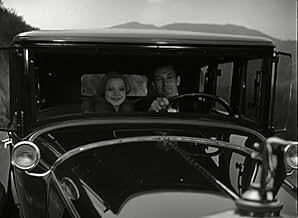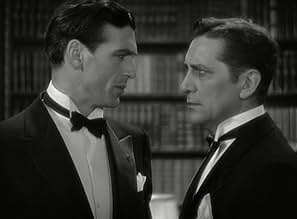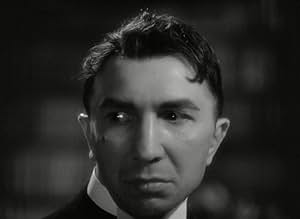IMDb-BEWERTUNG
7,0/10
2025
IHRE BEWERTUNG
Ein Mann tritt einer Gang bei, um seine Freundin aus dem Gefängnis zu befreien.Ein Mann tritt einer Gang bei, um seine Freundin aus dem Gefängnis zu befreien.Ein Mann tritt einer Gang bei, um seine Freundin aus dem Gefängnis zu befreien.
- Regie
- Drehbuch
- Hauptbesetzung
- Auszeichnungen
- 4 wins total
William 'Stage' Boyd
- McCoy
- (as William Boyd)
Terry Carroll
- Prison Inmate
- (Nicht genannt)
Allan Cavan
- Cop
- (Nicht genannt)
Bill Elliott
- Nightclub Patron
- (Nicht genannt)
Norman Foster
- Shooting Gallery Patron
- (Nicht genannt)
Paulette Goddard
- Nightclub Patron
- (Nicht genannt)
Bert Hanlon
- Baldy
- (Nicht genannt)
A.R. Haysel
- Fourth Henchman
- (Nicht genannt)
Matty Kemp
- Man Stabbed with Fork
- (Nicht genannt)
Empfohlene Bewertungen
I've only seen a couple of Sylvia Sidney's early films, but they all seem to feature at least one closeup of her face that reveals what's really going on in the picture. In Hitchcock's "Sabotage," there's a fascinating shot of her working at a theater box office when a guy she likes suddenly shows up unannounced. Hitchcock went in tight on her face as it slowly changes from a blank expression to a glow of sheer joy. I've never seen anything like it in any other film. And here, in "City Streets," the director dollies in and lingers on her face for a full minute while Hollywood cinema's first "voiceover" tells us what's going on in her thoughts. But really, the words are superfluous, because her brown, luminous eyes tell us everything. Sidney was perhaps too exotic and unconventional to compete for major stardom with the Clara Bow flappers and Jean Harlow blonds of her time. She was also difficult to get along with, according to some sources. But she is more timeless than most. Dashiell Hammett, who wrote "City Streets," said she was the best part of the movie. For me, she's the best part of any movie she's in.
If it had been made 2 years later it would have been BANNED! The number one MUST SEE recommendation of the day!. The best Rouben Mamoulian film I have seen this far (have but have not yet seen J+H).
There's no wonder why this film got less than 200 votes. A bigger greyzone that could not care less about what's proper would not be seen again until the 60's. As morally ambiguous and dark as 70's grit but with a certain charm as well. Of course this had to lay low in the later 30's and sadly it does not appear to have been re-discovered.
Seriously. This got it all. Great actors: Gary Cooper, Sylvia Sidney and the this time not so lovable Guy Kibbee. And a mighty good director. This far I haven't been RM's biggest fans but I have liked his films a lot and with this he steps into a new league. One of the best 30's films I have ever seen! This is something I never thought even existed! 9.5/10
There's no wonder why this film got less than 200 votes. A bigger greyzone that could not care less about what's proper would not be seen again until the 60's. As morally ambiguous and dark as 70's grit but with a certain charm as well. Of course this had to lay low in the later 30's and sadly it does not appear to have been re-discovered.
Seriously. This got it all. Great actors: Gary Cooper, Sylvia Sidney and the this time not so lovable Guy Kibbee. And a mighty good director. This far I haven't been RM's biggest fans but I have liked his films a lot and with this he steps into a new league. One of the best 30's films I have ever seen! This is something I never thought even existed! 9.5/10
This is an odd film for several reasons. For one it is a gangster film made at Paramount, home of the sophisticated continental comedies and dramas. Also, you have Gary Cooper in a modern dress role but with that Montana twang on full display.
Gary Cooper plays "The Kid", a sharp shooter at a circus. His best girl is Nan Cooley (Sylvia Sydney). I can't say why they are going together, because Nan seems to dislike all of "The Kid's" outlooks and plans for the future. Nan's dad is a gangster played by an oddly cast Guy Kibbee (Pop), who is usually associated with being the comic relief over at Warner Brothers.
Nan helps "Pop" out whenever he wants to get rid of a getaway car or dispose of a weapon, but then one night her ruse doesn't work and she winds up being sent up the river for possession of a gun used in a murder done by dear old dad. And apparently "pop" only makes weak attempts to get her out of jail, although while she is inside he does use the opportunity to recruit the kid into the beer racket because of his handiness with a weapon.
Nan gets out and for some reason now sees The Kid as irresistible - a real about face in her attitude with no reason given. However she is very upset that dear old dad has her beau in with the rackets. Oh, and "The Big Fellow" (Paul Lukas), apparent head of the rackets, wants to throw over his current long time girlfriend and replace her with Nan, regardless of what Nan and the Kid think about it. Complications ensue.
The story is really conventional gangster lore - nothing to write home about. What makes it interesting is Mamoulian's direction and shots. He likes to linger on faces or even a stuffed bird. He's not really an "action packed" kind of director. There is great atmosphere with the prohibition era night spots taken over by the rowdy gangsters and shadows on the dark streets.
What makes it fun are some of the inconsistencies. The urban shots are done so that you feel like you are in a big city of the Northeast US. People in coats, talk of the cold, etc. But then the final chase scene comes and you see palm trees, canyons - it is obvious you are in southern California. And what is Cooper's character's real name? Everybody just calls him "Kid". That is who he is billed as.
I'd say watch it and just have fun with it. It certainly is different from a Warner Brothers gangster picture of the same era.
Gary Cooper plays "The Kid", a sharp shooter at a circus. His best girl is Nan Cooley (Sylvia Sydney). I can't say why they are going together, because Nan seems to dislike all of "The Kid's" outlooks and plans for the future. Nan's dad is a gangster played by an oddly cast Guy Kibbee (Pop), who is usually associated with being the comic relief over at Warner Brothers.
Nan helps "Pop" out whenever he wants to get rid of a getaway car or dispose of a weapon, but then one night her ruse doesn't work and she winds up being sent up the river for possession of a gun used in a murder done by dear old dad. And apparently "pop" only makes weak attempts to get her out of jail, although while she is inside he does use the opportunity to recruit the kid into the beer racket because of his handiness with a weapon.
Nan gets out and for some reason now sees The Kid as irresistible - a real about face in her attitude with no reason given. However she is very upset that dear old dad has her beau in with the rackets. Oh, and "The Big Fellow" (Paul Lukas), apparent head of the rackets, wants to throw over his current long time girlfriend and replace her with Nan, regardless of what Nan and the Kid think about it. Complications ensue.
The story is really conventional gangster lore - nothing to write home about. What makes it interesting is Mamoulian's direction and shots. He likes to linger on faces or even a stuffed bird. He's not really an "action packed" kind of director. There is great atmosphere with the prohibition era night spots taken over by the rowdy gangsters and shadows on the dark streets.
What makes it fun are some of the inconsistencies. The urban shots are done so that you feel like you are in a big city of the Northeast US. People in coats, talk of the cold, etc. But then the final chase scene comes and you see palm trees, canyons - it is obvious you are in southern California. And what is Cooper's character's real name? Everybody just calls him "Kid". That is who he is billed as.
I'd say watch it and just have fun with it. It certainly is different from a Warner Brothers gangster picture of the same era.
The first thing that stuck me as I was watching this gem was the lack of a sound track. Other than the club scene where a band is jamming there is no music at all. The introduction of sound in film was so recent that technique hadn't been fully developed yet. But the strange thing is that the dialog was enough to fill that void. It actually didn't even appear as a shortcoming. And another strange thing: the bad guys were played by actors who always play honorable characters, Paul Lukas and Guy Kibbee, and boy are they despicable. Very good at it too, especially Kibbee. I never thought of that jovial, ebullient character actor as able to bring it off but he does, and well. As for Lukas he is evil incarnate. There's plenty of other reasons to watch this one. The story is gripping. The camera work was way ahead of its time. Character development is superior. And I could go on and on. If there was ever a film deserving to be digitized this one is it.
Clearly patterned after the first gangster movies that Warner produced the same year,Little Caesar (1931) and The Public Enemy (1931),this gangster movie is one of the better efforts I've seen. Although not quite in the same league as the previous mentioned classics, it has a powerful performance by young Sylvia Sidney.She's magnificent and delivers her lines more natural than perhaps anyone did at the time.Gary Cooper is better than usual at this stage in his career and shows signs of what would follow the next few years when he rose to the top. The movie has some fascinating villains in Paul Lukas (never seen him this detestable) and Guy Kibbee (what a shock to see him act the hoodlum).The direction of Rouben Mamoulian is very inventive,probably the first voice-over to show a persons thoughts appear in this movie. If you get the chance to see this little gangster flick, don't let the chance go by.
Wusstest du schon
- WissenswertesThis was Clara Bow's last film on her five-year contract, but due to her nervous breakdown, Sylvia Sidney replaced her after Nancy Carroll declined the part.
- PatzerWhen the henchman is talking to the out-of-town hit men, he gives Pop's address as beginning with a "6" before the scene cuts away. In the next scene, the address of the building is "165".
- VerbindungenFeatured in Hollywoodism: Jews, Movies and the American Dream (1998)
Top-Auswahl
Melde dich zum Bewerten an und greife auf die Watchlist für personalisierte Empfehlungen zu.
- How long is City Streets?Powered by Alexa
Details
- Erscheinungsdatum
- Herkunftsland
- Sprache
- Auch bekannt als
- Straßen der Großstadt
- Drehorte
- Produktionsfirma
- Weitere beteiligte Unternehmen bei IMDbPro anzeigen
- Laufzeit
- 1 Std. 23 Min.(83 min)
- Farbe
Zu dieser Seite beitragen
Bearbeitung vorschlagen oder fehlenden Inhalt hinzufügen







































